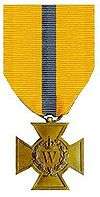Bronze Cross (Netherlands)
| Bronze Cross | |
|---|---|
 | |
|
Awarded by | |
| Type | Military award |
| Eligibility | Military Personnel, merchant navy and civilians in the resistance |
| Awarded for | Acts of courage and leadership in the face of the enemy. |
| Campaign | World War II and later campaigns |
| Status | Currently awarded |
| Description | The medal is a bronze cross pattée. A wreath consisting of tendrils of oak and laurel leaves is tied around the royal cypher. |
| Clasps | none; if the cross is awarded again a large Arabic golden figure "2" or "3" is attached to the ribbon. |
| Statistics | |
| First awarded | 11 June 1940 |
| Last awarded | On 7 October 2009 to 1st Lt Alex Spanhak for his actions in Afghanistan |
| Total awarded | 3,501 |
| Posthumous awards | Posthumous awards are possible |
| Precedence | |
| Next (higher) | Resistance Star East Asia |
| Next (lower) | Cross of Merit |
|
Ribbon bar of the Bronze Cross | |
The Bronze Cross of the Kingdom of the Netherlands (Dutch: "Het Bronzen Kruis") was instituted on 11 June 1940 by Queen Wilhelmina of the Netherlands while she was residing in London during the German occupation of the Netherlands. The Bronze Cross has precedence after the Resistance Star East Asia, but is the third highest military decoration still being awarded for bravery.
Several British, American, Canadian and Polish soldiers are among the 3,501 recipients of the Bronze Cross that is awarded by Royal Decree.
External links
- Bronze Cross - Official site of the Chancellery of the Netherlands Orders (English)
- Vereniging DMD - Website of the organization of veterans with the Bronze Cross (Dutch)
This article is issued from Wikipedia - version of the 11/9/2016. The text is available under the Creative Commons Attribution/Share Alike but additional terms may apply for the media files.